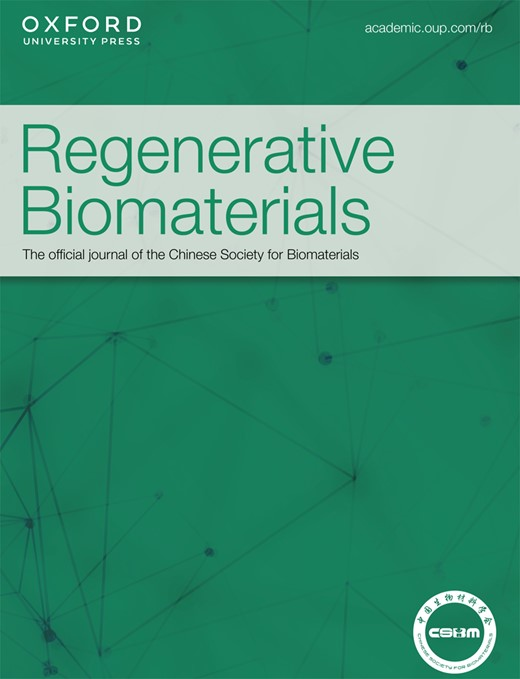Fe-Zn alloy, a new biodegradable material capable of reducing ROS and inhibiting oxidative stress
IF 8.1
1区 医学
Q1 MATERIALS SCIENCE, BIOMATERIALS
引用次数: 0
Abstract
Fe-based biodegradable materials have attracted significant attention due to their exceptional mechanical properties and favorable biocompatibility. Currently, research on Fe-based materials mainly focuses on regulating the degradation rate. However, excessive release of Fe ions during material degradation will induce the generation of reactive oxygen species (ROS), leading to oxidative stress and ferroptosis. Therefore, the control of ROS release and the improvement of biocompatibility for Fe-based materials are very important. In this study, new Fe-Zn alloys were prepared by electrodeposition with the intention of using Zn as an antioxidant to reduce oxidative damage during alloy degradation. Initially, the impact of three potential degradation ions (Fe2+, Fe3+, Zn2+) from the Fe-Zn alloy on human endothelial cells’ (ECs) activity and migration ability was investigated. Subsequently, cell adhesion, cell activity, ROS production, and DNA damage were assessed at various locations surrounding the alloy. Finally, the influence of different concentrations of Zn2+ in the medium on cell viability and ROS production was evaluated. High levels of ROS exhibited evident toxic effects on ECs and promoted DNA damage. As an antioxidant, Zn2+ effectively reduced ROS production around Fe and improved the cell viability on its surface at a concentration of 0.04 mmol/L. These findings demonstrate that Fe-Zn alloy can attenuate the ROS generated from Fe degradation thereby enhancing cytocompatibility.能减少 ROS 和抑制氧化应激的新型可生物降解材料--铁锌合金
铁基生物降解材料因其优异的机械性能和良好的生物相容性而备受关注。目前,有关铁基材料的研究主要集中在降解速率的调节上。然而,材料降解过程中铁离子的过度释放会诱发活性氧(ROS)的产生,从而导致氧化应激和铁变态反应。因此,控制 ROS 释放和改善铁基材料的生物相容性非常重要。本研究采用电沉积法制备了新型铁锌合金,目的是利用锌作为抗氧化剂来减少合金降解过程中的氧化损伤。首先,研究了铁锌合金中三种潜在降解离子(Fe2+、Fe3+、Zn2+)对人内皮细胞(ECs)活性和迁移能力的影响。随后,对合金周围不同位置的细胞粘附性、细胞活性、ROS 生成和 DNA 损伤进行了评估。最后,还评估了培养基中不同浓度的 Zn2+ 对细胞活力和 ROS 生成的影响。高浓度的 ROS 对心血管细胞有明显的毒性作用,并促进 DNA 损伤。作为一种抗氧化剂,当浓度为 0.04 mmol/L 时,Zn2+ 能有效减少铁周围的 ROS 生成,并提高铁表面的细胞活力。这些研究结果表明,铁-锌合金可以减少铁降解产生的 ROS,从而提高细胞相容性。
本文章由计算机程序翻译,如有差异,请以英文原文为准。
求助全文
约1分钟内获得全文
求助全文
来源期刊

Regenerative Biomaterials
Materials Science-Biomaterials
CiteScore
7.90
自引率
16.40%
发文量
92
审稿时长
10 weeks
期刊介绍:
Regenerative Biomaterials is an international, interdisciplinary, peer-reviewed journal publishing the latest advances in biomaterials and regenerative medicine. The journal provides a forum for the publication of original research papers, reviews, clinical case reports, and commentaries on the topics relevant to the development of advanced regenerative biomaterials concerning novel regenerative technologies and therapeutic approaches for the regeneration and repair of damaged tissues and organs. The interactions of biomaterials with cells and tissue, especially with stem cells, will be of particular focus.
 求助内容:
求助内容: 应助结果提醒方式:
应助结果提醒方式:


